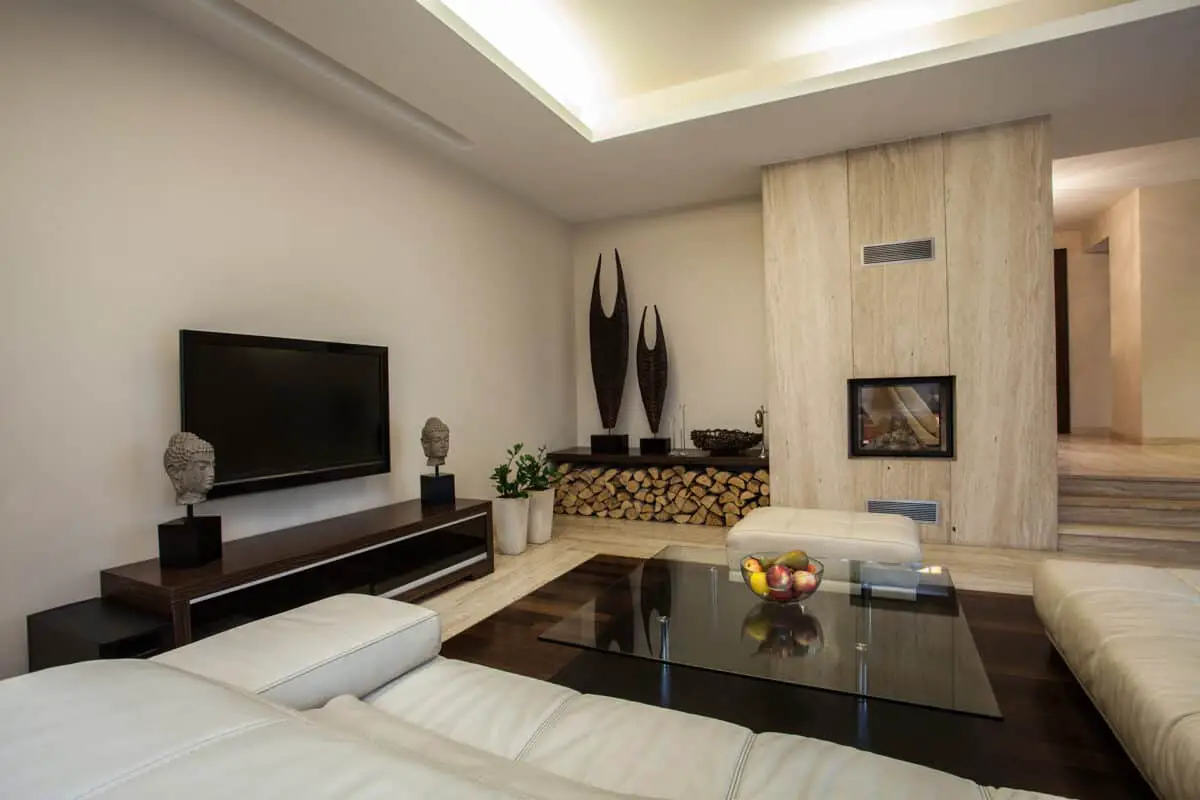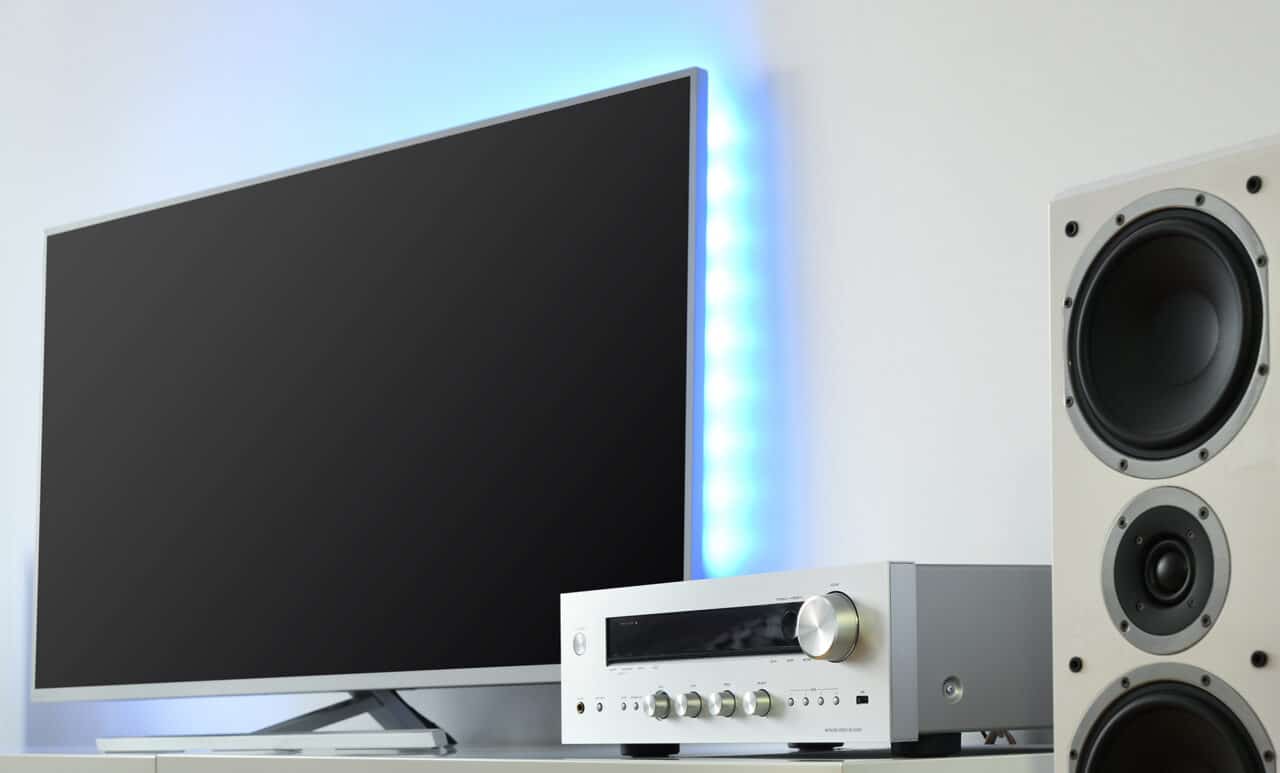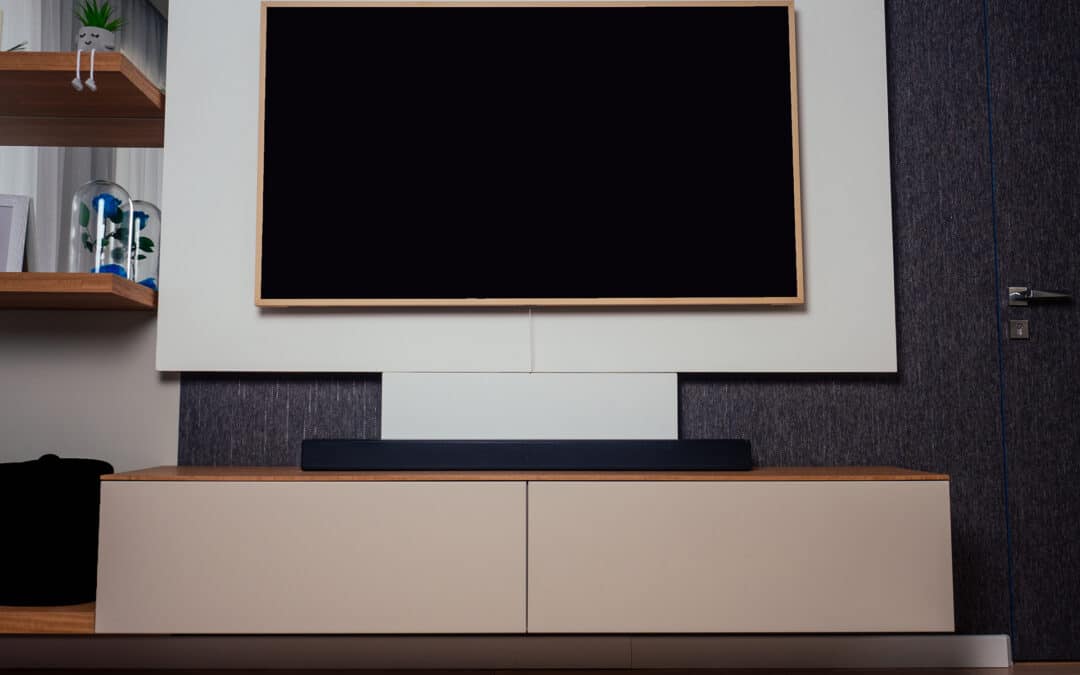Audio receivers are integral parts of a home theater sound system, but you may wonder how to effectively hide your audio receiver. They are bulky enough to get in the way and ruin the aesthetics of the room. There’s also always the chance that someone will just keep trying to use the wrong thing, so getting something that isn’t needed to be utilized as frequently out of the way is beneficial.
Just remember that technology uses electricity and thus gets hot and typically needs some ventilation. Additionally, audio receivers have a limited range, and the more obstacles between them and what is connected make them less effective. With that all said, keep reading for some of the best ways to hide an audio receiver in a room to leave it looking picture-perfect.
Table of Contents
Shut it in a Cabinet
There’s a reason people are willing to pay for fancy TV stands. It’s not just for looks but also because they’re designed to hide equipment and support the screen. These cabinets are also pretty much expected to be part of a setup so they won’t take away from the aesthetics.
However, if that perfect TV cabinet is out of budget or the one without doors won out in the design debate, the audio receiver can be tucked into plenty of other cabinets.
Such cabinets may include:
- Overhead: like those commonly seen in a kitchen.
- Built-ins: even those not directly next to the television.
- Free standing: like a wardrobe, chest of drawers, or just a general multipurpose cabinet.
Basically, if there’s a cabinet free nearby, it can be utilized to hide the receiver. Any kind will do as long as it fits comfortably and can be accessed if needed.
Audio receivers usually don’t even have to be close to the TV, depending on the model. If there aren’t cables to worry about, it can go just about anywhere within range. Some folks even like to dedicate a whole cabinet just for equipment or to get dedicated utility cabinets.
Run it to the Floor Below
Is there an unfinished basement underneath where the receiver will be installed? That might end up being the perfect place to hide an audio receiver. That way, it’s close, but out of sight. There also won’t be any significant damages needing to be repaired once the installation is complete since there isn’t going to be a ceiling.
There’s also always the option of just running it through the floor below. However, if it’s a finished room, it could be a bit more costly. Not to mention, certain rooms are not suitable for storing technology. For example, you don’t want the steam from the shower or smoke from the kitchen getting all over it.
From there, it can either be left out in the open or put into something else. Typically, when people run their equipment through the floor, they mount it on the underside. Just make sure that it continues to be accessible and clean.
Don’t build it into the lower floor’s ceiling; it will get costly whenever it needs to be dealt with. Also, don’t put it into the crawlspace. Otherwise, it will be a pain to get to and likely gross!
Hide it in the Wall
As long as the walls are large enough and it’s not a rental property, a nifty hiding spot is always the wall itself. Think of it like a bathroom medicine cabinet that sits flush with the wall. There’s a cubby to put things into; in this case, an audio receiver.
Alternatively, there is also the option to build a false wall and hide all the TV equipment in it that way. It should go without saying that this option will add a lot of bulk to the wall and thus decrease the size of the room. However, it can look amazing when it’s all said and done. So, if there’s enough space in the room to sacrifice a little bit of it, it can be a great option.
Some people get pretty creative with wall cubbies too. Some have obvious doors, whereas others are hidden behind paneling, a mirror, or a photograph like in an old spy movie. There are a lot of possibilities if there are space, time, and funds to make it happen for sure.
Utilize Decorative Boxes
Sometimes the TV stand has open shelving. That’s fine for most things but it doesn’t help hide equipment. Thankfully, a billion places are selling decorative boxes for just this sort of thing. Just pick out something that will fit both the space and the receiver and now it’s a nice piece of décor instead of an eyesore.
The best part about these is that they are often pretty inexpensive. So they can be changed for seasons, holidays, or just whenever the whim wills it without breaking the bank every time. If there are a few in the same area, it will look even more intentional and less out of place too. Just remember which box it’s in!
Plus, a decorative box can come in handy if the audio receiver has wires. Some have handles or generic holes that wires can easily slip through to keep them neatly tucked behind. It’s an old method, but it’s effective.
Blend it in with the Décor
Ever heard the saying, “if you can’t beat ‘em, join ‘em”? The same goes for design. If it comes down to it, stop trying to hide the receiver and instead try to use it as part of the surrounding décor. Some newer models even look pretty sleek so they can work with a little bit of creativity.

Here are a few things that might help blend in an audio receiver with the décor around it:
- Books
- Gaming consoles
- Holiday décor
- Crafts
- Family photographs
- Signs
- Figurines
If things are light enough, the receiver can always be used as a small pedestal. Just don’t put something like a plant or a fountain on it. That way, there’s no risk of getting it wet.
Remember color and shape when trying to blend it with what’s around it. It will stand out like a sore thumb if it’s black in the middle of bubbly soft pastels, but amid some hard-edged neutrals, it can fall back with the rest.
Alternatively, using a more modern scheme in the area where it’s black, white, and a pop of color can be a perfect option, as most receivers are black themselves. Then, the pop of color will draw attention to it rather than the receiver and thus make it less noticeable.
Tuck it Under the Sofa
Unless it’s one of the high-end, super sleek, and fancy models, the audio receiver should be close to the system it controls. What else is close to that? Seating. If it’s something like a big, clunky sofa that isn’t going to get moved around much, that can be an excellent spot to hide it.
This is especially true if there is little to no risk of children or pets getting under and messing with it. Additionally, try to keep it away from dustier areas. The underside of infrequently moved furniture will always get dirty, but not as bad in some rooms as in others. Just be mindful!
Look at how the underside of the seating is made before trying to cram it under there. Some are more suited for it than others. For example, don’t stick it under a recliner and risk getting smashed in the moving parts. Find something that will give it enough room to disperse heat, not get damaged by someone sitting above it, and also stay clean and dry.
Build it into a Shelf
If there is ever something cooler than it needs to be, it’s custom built shelving units. Anything from bookshelves to built-ins, they’re always fantastic. If working on something like that, consider adding in a space to slot the audio receiver into. It can be just a perfectly sized slot for it, or it could be tucked in a drawer or behind a door. Whatever fits individual preferences and needs.
If not building an entire shelving unit, most shelves can be pretty easily modified. It’s not hard to get a hinge, a chunk of wood, and some screws to make a functional hideaway. Plus, it can be customized with different handles and closing mechanisms if just letting a chunk of wood hang there isn’t quite good enough.
Just remember not to make it perfectly the same size. Otherwise, it won’t have room to disperse heat. This could lead to it overheating itself and breaking or damaging whatever is around it. Just be sure to read up on how much room that particular audio receiver model will need before locking it away into something like this.
Mount it onto the Ceiling
Most people don’t even notice a ceiling in the first place, and if they do, it quickly becomes an afterthought. There’s a reason it’s such a commonly used trope in horror movies to have things on the ceiling where none of the characters look. When was the last time anyone took notice of a ceiling? Chances are, not recently. So, utilize that and put it above everyone’s head where it will be out of sight and out of mind.
The thought comes from how anyone familiar with projectors has probably seen one that has been mounted to a ceiling. If not the projector itself, on this thin little shelf with the projector on top of it like a little hanging basket. There are all sorts of mounts out there for projectors to be mounted to the ceiling, and some of them are perfect to use with other equipment. It might not perfectly fit like some projector setups, but it is definitely an option.
Another one also involves building a custom one to mount it up there. Something like that could always be painted to blend in with the ceiling and nearby wall(s) to help it fade into everything from the edges of someone’s vision.
Dedicate a Closet
Closets aren’t just in bedrooms. Sometimes there are closets in the hallway, linen closets, cleaning closets, or even closets specifically for hiding away tech and equipment. It’s not weird to stash something like an audio receiver into one since they’re meant to put things out of the way.
Some wireless receivers have a strong enough signal to even be placed a room or so over. So, suppose there’s space in a nearby closet. In that case, it might be worth sticking the audio receiver there, too, especially in older homes where it might not be feasible to do enough renovations to make room for a custom equipment setup. Plus, it helps keep everything cool if it’s not crammed into a tiny space.
Find a Basket
Similarly to the decorative box, you can use a basket. Some receivers need a lot of ventilation, so having something like a basket can help give it that while also tucking it out of the way. Some more woven baskets can even mask what’s inside of them despite being able to be seen through up close, some have lids, and some are a bit of both. Not only that, but they often also have handle holes so any wired receiver can be strung through.
That makes them a perfect idea for tucking away ugly tech. They also tend to look good on shelves, enough so that it’s becoming a popular addition to design. If that wasn’t enough, it adds some privacy to open spaces like exposed shelving or empty tabletops. Some of the lovely, lidded ones can even be stuck on the ground and used as a light shelf so that it could pull double duty there!
Rely on Another Room
As long as the audio receiver is a model that has a strong enough signal, simply tucking the receiver in an adjacent room is a practical, easy, and costless way of hiding it. Stick it somewhere where the aesthetics don’t matter as much or have the means of tucking it away a little easier.
Shove it Behind the TV
If there’s enough space to stick it without getting the TV pushed too far forward, an easy option is to stick the audio receiver behind it. If possible, the TV will do most of the work hiding the receiver behind the feet for a tabletop model.
The best part about this is that it will have little trouble receiving and sending signals since it will be very close to where a good chunk of the audio will be anyway. This also means that any remotes, apps, or Bluetooth devices that need to connect to it will have nothing to interfere with its signal.

Drop it in a Drawer
Most of the time, technology gets shoved behind a door since that tends to have more space. Sometimes, there are even multiple shelves to keep everything neat and organized.
However, not everyone necessarily wants a proper door to hide their audio receiver in, so opting for a drawer that isn’t going to swing out or be easy for pets and children to open might be the way to go. It can also be the perfect use for one of those awkwardly sized drawers nobody knows what to use in some cabinets!
There are also those drawers that can have their faces dropped down, which, if accessible, makes for a great hiding spot for an audio receiver. That way, it doesn’t have to be taken out if something needs to be done with it, but it also will seamlessly push out of the way for all of the other times.
Find a Footrest
Some ottomans have a removable top to reveal storage space. That usually makes for good places to hide things that need to be nearby but are not always needed. If the audio receiver happens to be a wireless model, that could be a perfect place to stash one.
The only point of concern is that often times ottomans have a fabric interior which isn’t necessarily the best thing to have surrounding electronics. It can make it pretty hard for it to disperse heat properly. However, the interior look doesn’t usually matter, so that can usually be altered to expose the underlying construction.
Additionally, a few footrests/ottomans are made with just a cushioned top, whereas the rest is wooden or metal. One of those would be ideal for storing electronic equipment close by in a stylish manner.
Reuse an Old Container
Upcycling is big nowadays. It’s a thrifty way to spruce up old or broken things, helps work the creative parts of the brain, and also help to reduce waste. Quite a few products come in containers that could easily hold an audio receiver, so consider taking one, cleaning it out, and letting the creative juices flow.
As always, ensure it has adequate air, so it doesn’t overheat!
Here are a couple of ideas on how to upcycle an old container so that it looks less like trash and more like a nice piece of art:
- Paint the outside either plain or a pattern to match the nearby décor.
- Cover it in stickers, newspaper clippings, or photographs.
- Duct tape comes in many colors and styles nowadays.
- Wrap it in paper like a present; bonus points if a separate top is used with a bow.
- Washi tape is a crafter’s best friend for a reason.
- Glue on bits and bobs, clean sticks, or strips of fabric.
- Make a cozy by knitting, crocheting, or any other needlework.
You might as well make something useful from what would have been wasted. It can even be a nice activity with the kids to make them feel included in the room’s design, especially if it’s a family space. All in all, it’s a pretty solid win/win!
Hide Your Audio Receiver Conclusion
An audio receiver is essential for a nice sound system for a home theater. It connects all speakers to the screen, whether a television or a projector, for the best video experience. That means it has to be somewhere that it can do its job, which also usually means that there will be an unsightly box in the way.
Fortunately, most of these can be pretty easily tucked away. Some newer models don’t even have to be in the same room and can be used for multiple screens! That means that people can get really creative when hiding their audio receivers.
Anything from tucking it into a TV cabinet to building it into something to using upcycled old containers to create custom works of art. They don’t have to be in the way when there are other, easy options for putting it out of sight and out of mind.
Just be sure that wherever they get squirreled away, they have plenty of room to stay cool and limit the number of obstacles between them and the system they are connected to. That way, the sound in every movie night can be perfect.
